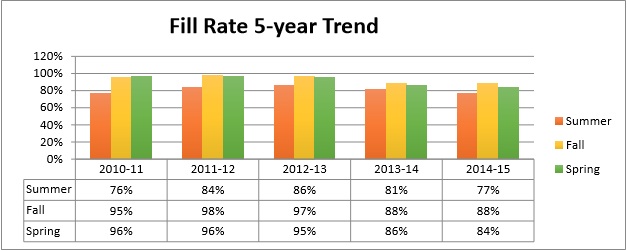Santa Rosa Junior College faculty gathered March 5 to discuss potential solutions for low enrollment, an issue troubling SRJC officials since the 2009 recession.
According to enrollment data, the college has at times seen over the past seven years nearly 9,500 fewer students during a single semester. The lack of new students affects the college’s fill rate, or enrollment at first census, which has created an ongoing deficit.
This realization has many college administrators and faculty asking why fewer people are attending the college and how SRJC can regain the headcount once again.
SRJC President Dr. Frank Chong tasked Ricardo Navarrette, vice president of student services, and Mary Kay Rudolph, senior vice president of academic affairs, with developing a strategic enrollment management plan to help fill seats over the next three years.
Navarrette and Rudolph presented a proposal to the faculty, which included a comprehensive plan to target senior high school students and the increasing Latino population.
Faculty voiced concern for outreach to the Latino population, worried that they were overlooked in the outreach efforts, and in turn were not aware of their opportunities to attend college.
“I want every student who wants to go to college to be able to go to college,” Chong said. “If there are populations that we’re not talking to, then we have more work to do.”
Many attendees agreed the greatest barrier for young college students in recent times has been the increasing rent prices, which cause many students to reduce the number of units they enroll in, or worse, skip higher education all together.
“Over time there has always been a correlation between the employment rate and enrollment at the community college,” Navarrette said. “For the exact segment of the population that we are talking about, the challenge becomes ‘do we go to college or go to work?’”
Navarrette and Rudolph acknowledged rent prices have increased 40 percent throughout the county, but also believe there are other contributing factors as well.
Navarrette suggested there is a need for earlier introduction to the idea of attending college and mentioned the potential recruitment of a full-time employee to facilitate an “early success program,” which would provide outreach to middle school age youth and encourage them to pursue higher education and consider SRJC as an option.
Several faculty members suggested the biggest issue the college faces among the affluent population is the stigma around community colleges. With college admission competition high and so many high school administrators pushing young people to apply directly to four-year institutions, many students miss the opportunities available to them at SRJC.
Navarrette agreed one area that needs improvement is the reputation SRJC has within the community, including the high school administrators who act as a gateway for many youth and families.
“High school mentality among the administrators and the parents is for the high-caliber student. They measure success by admission standards,” Navarrette said.
Over the next three years, Navarrette and Rudolph’s goal will be to increase overall enrollment by 2 percent each year. By reaching out to potential students earlier and finding and targeting the overlooked populations, they hope to regain the student population SRJC once had.


